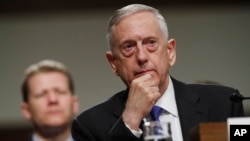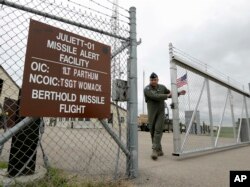Defense Secretary Jim Mattis said Wednesday he has become convinced that the United States must keep all three parts of its nuclear force, rather than eliminate one, as he once suggested.
Some argue that ground-based missiles may no longer be necessary to America's policy of deterrence, and the Trump administration has been reviewing the military's nuclear posture.
Mattis has called the submarine-based component “sacrosanct” and has said it is necessary to retain the ability to fire nuclear weapons from planes.
Together, those three prongs constitute what the military calls its nuclear triad.
Before he took over in January as President Donald Trump's Pentagon chief, Mattis had suggested that long-range, silo-based weapons, known as intercontinental ballistic missiles (ICBMs), might be expendable.
“I've questioned the triad,” Mattis told reporters flying with him to Minot Air Force Base, a nuclear base in northwestern North Dakota. He said his view has changed.
“I cannot solve the deterrent problem reducing it from a triad. If I want to send the most compelling message, I have been persuaded that the triad in its framework is the right way to go,” Mattis said.
Mattis has previously indicated this evolution in thinking, but his statements Wednesday were emphatic.
The key to avoiding nuclear war, he said, is maintaining a nuclear arsenal sufficient to convince a potential enemy that attacking the U.S. with a nuclear weapon would be suicidal.
“You want the enemy to look at it and say, this is impossible to take out in a first strike, and the [U.S.] retaliation is such that we don't want to do it,” he said. “That's how a deterrent works.”
Thus the U.S. will keep nuclear missile submarines, land-based nuclear missiles and nuclear-capable aircraft, he indicated.
New START treaty review
Mattis also said the Trump administration is reviewing the value of the New START treaty negotiated with Russia by the Obama administration in 2010. The treaty, already in effect, requires reductions by both sides to a maximum of 1,550 strategic nuclear warheads by February.
“We're still engaged in determining whether it's a good idea,” Mattis said, adding that the question is linked to adherence by others to separate but related arms treaties. That was an apparent reference to U.S. allegations that Russia is violating the Intermediate-range Nuclear Forces treaty from 1987.
Mattis declined to discuss the matter further, except to say the administration is not considering withdrawing from New START.
Trump has criticized New START as a bad deal for America.
Mattis' trip was scheduled before the recent series of North Korean nuclear and missile tests. But those test were giving Mattis a chance to highlight what the Air Force promotes as an always-ready fleet of land-based missiles and B-52 bombers equipped to deliver nuclear devastation to nearly any point on the globe in short order.
The Minot base is home to more than 100 land-based nuclear missiles as well as nuclear bomb-carrying aircraft. After arriving at Minot, Mattis was flown by Huey helicopter to a “missile alert facility” and taken underground to a Minuteman launch control capsule.
Keeping ‘enemies at bay’
He spoke to a missile launch crew on duty, including 2nd Lt. Tia Hewuse, who later told reporters that she expressed to Mattis her pride in serving as part of the nation's nuclear deterrent.
“It's what keeps our enemies at bay,” she said.
Mattis also was touring a Minot facility where nuclear warheads are stored, and visiting with a B-52 bomber unit.
Minot hosts the 91st Missile Wing, which operates one-third of the nation's 400 Minuteman 3 missiles, as well as the 5th Bomb Wing, which flies those nuclear-capable bombers.
Minot in recent years was at the center of trouble in the ICBM force, including lapses in morale, training, performance and management. The Air Force has made an effort since 2014 to correct those weaknesses, which had accumulated over a period of years, with little attention from Congress.
Minot and Strategic Command headquarters at Offutt Air Force Base in Nebraska are timely backdrops for a related political message: The Trump administration intends to press ahead with a multibillion-dollar modernization of the entire nuclear arsenal.
The Pentagon is in the midst of an in-depth review of nuclear weapons policy, but it seems clear that upgrading the Cold War-era nuclear force is a foregone conclusion.
Last month the Pentagon signaled its intentions by awarding two key contracts.
One was to Northrop Grumman and Boeing, totaling nearly $700 million, for further development of an ICBM to replace the Minuteman 3. The other was to Lockheed Martin and Raytheon for $1.8 billion to work on a new nuclear-armed, air-launched cruise missile.
The Air Force also is proceeding with development of a next-generation nuclear-capable bomber, called the B-21 Raider, and the Navy is building a new fleet of strategic nuclear submarines.
Mattis in recent weeks has all but dismissed the idea, which he raised himself in congressional testimony two years ago, that the country might be better off eliminating the ICBM fleet.
In June, the Air Force finished reducing the number of Minuteman 3 missiles by 50 to a total of 400, the lowest since 1962. But Mattis appears to have been persuaded by the argument that keeping ICBMs deployed in underground silos sprinkled across the western Great Plains is key to deterrence because an attacker would have to use hundreds of weapons to destroy all 400 launch facilities.






